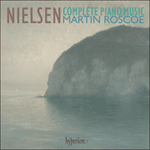This
Suite Op 45 is perhaps Nielsen’s single most important work for piano, which he completed in summer 1919. Here the scheme involves the gradual emergence, from cell-like beginnings, of B flat as the work’s ultimate goal and ‘home key’ (in the expressive as well as structural sense). B flat first appears as the pivotal bass pedal in the first movement, and then as an element in the strange unearthly sonority which opens the second. The third movement, a stirring Molto adagio, begins confidently in G minor, only to close in B flat—but the status of B flat as a tonic is only provisional at this stage, and the fourth and fifth movements make no reference to this tonality at all. Indeed, it is not until the dramatic
Hammerklavier-like quavers of the very closing bars of the finale that B flat is genuinely established as a stable reference point, and the piece can be brought to a decisive conclusion. Nielsen originally referred to the work as ‘Ild og Vand’ (‘Fire and Water’), a reference to the music’s elemental nature that may also have inspired its later subtitle,
Luciferisk (‘The Luciferian’), which Nielsen used for the first performance in March 1921 but later dropped. Nielsen was evidently thinking of Lucifer as the bringer of fire and light, rather than in his more satanic incarnation, although there are times, particularly in the third and final movements, when the music almost feels possessed by some kind of demonic spirit. Yet the
Suite also shares Nielsen’s earlier preoccupations with Baroque counterpoint, Mozartian elegance, and Haydnesque inventiveness: it is amongst Nielsen’s most powerfully diverse and eclectic works.
from notes by Daniel Grimley © 2008
Des propensions à la tonalité progressive transparaissent dans la
Suite, op. 45, peut-être la seule partition pianistique de très grande envergure jamais écrite par Nielsen (il l’acheva à l’été de 1919). Ici, le schéma implique l’émergence graduelle, à partir d’amorces cellulaires, de si bémol en tant que but ultime et «tonalité mère» (au sens expressif et structurel) de l’œuvre. Pédale de basse-pivot du premier mouvement, si bémol s’intègre ensuite à l’étrange sonorité surnaturelle qui marque le début du volet suivant. Le troisième mouvement, un vibrant Molto adagio, démarre avec confiance en sol mineur, mais pour se refermer en si bémol, dont le statut de tonique n’est alors que provisoire, les quatrième et cinquième mouvements n’y faisant pas la moindre allusion. Et de fait, il faut attendre les théâtrales croches à la
Hammerklavier des ultimes mesures du finale pour que si bémol devienne vraiment un point de référence stable; la pièce est alors conduite à une conclusion déterminée. Au départ, Nielsen baptisa cette œuvre «Ild og Vand» («Le fue et l’eau»), en référence au côté «éléments» de cette musique, qui a pu inspirer le sous-titre
Luciferisk («La luciférienne») utilisé lors de sa création, en mars 1921. Nielsen, qui renonça bientôt à cet intitulé, voyait à l’évidence plus le Lucifer porteur de feu et de lumière que l’incarnation satanique, même si sa musique semble parfois (surtout dans le troisième et le dernier mouvements) presque possédée par une sorte d’esprit démoniaque. Mais cette
Suite témoigne aussi de son goût pour le contrepoint baroque, l’élégance mozartienne et l’inventivité haydnesque—elle compte d’ailleurs parmi ses pages les plus puissamment diversifiées et éclectiques.
extrait des notes rédigées par Daniel Grimley © 2008
Français: Hypérion
Suite op. 45 ist womöglich das bedeutendste Klavierwerk von Nielsen. Er schloss es im Sommer 1919 ab. Formal gibt es eine allmähliche Entwicklung von einem Anfang aus wenigen Zellen, aus denen sich B-Dur als das wichtigste Ziel und die „Grundtonart“ (sowohl was den Ausdruck als auch seine Funktion betrifft) herausschält. B taucht zum ersten Mal im ersten Satz auf, in Form eines entscheidenden Orgelpunkts im Bass. Dann bildet es ein Element in der merkwürdig immateriellen Klangwelt, die den zweiten Satz eröffnet. Der dritte Satz, ein bewegendes Molto adagio, beginnt selbstbewusst in g-Moll, schließt dann aber in B-Dur—allerdings ist der Status des Bs als eine Tonika zu diesem Zeitpunkt nur vorübergehend. Der vierte und fünfte Satz beziehen sich überhaupt nicht auf diese Tonart. Tatsächlich wird B als stabiler Bezugspunkt erst bei den dramatischen hammerklavierartigen Achteln in den allerletzten Takten des Schlusssatzes richtig bestätigt. Erst jetzt kann das Stück zu einem entschlossenen Abschluss gebracht werden. Nielsen nannte das Werk ursprünglich „Ild og Vand“ („Feuer und Wasser“), eine Bezugnahme auf die elementare Natur der Musik, die auch den späteren Untertitel,
Luciferisk („Luziferisch“), inspiriert haben mag, den Nielsen bei der Uraufführung im März 1921 anführte, später aber fallen ließ. Nielsen stellte sich Luzifer offensichtlich eher als den Überbringer von Feuer und Licht als eine satanische Figur vor, obwohl es Momente gibt, besonders im dritten und im letzten Satz, wo die Musik fast von einer Art dämonischen Geistes besessen zu sein scheint. Doch lässt die
Suite auch die in Nielsens früheren Werken zum Ausdruck gekommene Neigung zu barockem Kontrapunkt, zu einer an Mozart mahnenden Eleganz und einen an Haydn erinnernden Einfallsreichtum erkennen. Die
Suite gehört zu Nielsens überzeugend vielseitigsten und eklektischsten Werken.
aus dem Begleittext von Daniel Grimley © 2008
Deutsch: Elke Hockings


 Nielsen: Complete Piano Music
Nielsen: Complete Piano Music
